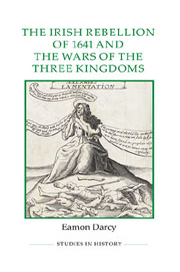Book contents
- Frontmatter
- Contents
- Acknowledgements
- Abbreviations
- Introduction
- 1 Representing violence and empire: Ireland and the wider world
- 2 Imagined violence? The outbreak of the 1641 rebellion in Ireland
- 3 Manufacturing massacre: the 1641 depositions and the Wars of the Three Kingdoms
- 4 The 1641 rebellion and violence in the New and Old Worlds
- 5 Contesting the 1641 rebellion
- Conclusion: The 1641 rebellion in its British, European and Atlantic world context
- Bibliography
- Index
2 - Imagined violence? The outbreak of the 1641 rebellion in Ireland
Published online by Cambridge University Press: 05 May 2013
- Frontmatter
- Contents
- Acknowledgements
- Abbreviations
- Introduction
- 1 Representing violence and empire: Ireland and the wider world
- 2 Imagined violence? The outbreak of the 1641 rebellion in Ireland
- 3 Manufacturing massacre: the 1641 depositions and the Wars of the Three Kingdoms
- 4 The 1641 rebellion and violence in the New and Old Worlds
- 5 Contesting the 1641 rebellion
- Conclusion: The 1641 rebellion in its British, European and Atlantic world context
- Bibliography
- Index
Summary
Accounts written after the 1641 rebellion expressed surprise that the native Irish took arms against the colonial order. Under the happy stewardship of King Charles i, they argued, the three kingdoms enjoyed relative peace and tranquillity in comparison to the ‘distempers’ of Europe. This might explain why modern-day historians have emphasised the peaceful condition of Ireland in the 1630s. Such sentiments, however, were a deliberate reconstruction of the past in order to paint life in Stuart Ireland and Britain in the best possible light. In truth, the end of Charles's reign was fraught with tension. Matters were not helped by the personality of the monarch; Charles lacked the sort of traits that would have been conducive to dealing with, or mitigating, opposition caused by his various fiscal, social and religious policies. In Ireland rumours that trouble was afoot in the three kingdoms circulated from the mid-1630s, which drastically unsettled local communities, particularly when the Bishops' Wars broke out in Scotland. The actions of those who adhered to the Scottish National Covenant would reverberate across the three kingdoms for the following two decades.
The background to the 1641 rebellion
The presence of a new Protestant and English social order greatly exacerbated tensions in Ireland throughout the early seventeenth century. The frequent use of martial law, the expansion of the Stuart state and the plantation of Ulster could prompt violent unrest, as was attempted during the O'Catháin conspiracy of 1615.
- Type
- Chapter
- Information
- Publisher: Boydell & BrewerPrint publication year: 2013



